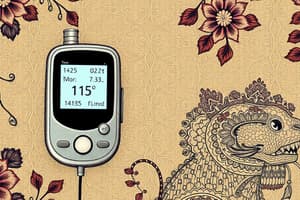Podcast
Questions and Answers
What is the primary purpose of using a glucose monitor according to the speaker?
What is the primary purpose of using a glucose monitor according to the speaker?
The primary purpose is to understand how dietary and lifestyle choices affect glucose levels in the body.
How does the speaker suggest glucose monitoring can impact a person's awareness of their health?
How does the speaker suggest glucose monitoring can impact a person's awareness of their health?
Glucose monitoring increases awareness and agency over glucose trends, preventing surprises like pre-diabetes diagnoses.
What indicates a normal response of glucose levels after eating in a healthy individual?
What indicates a normal response of glucose levels after eating in a healthy individual?
In a healthy individual, glucose should peak within 45 minutes after a meal and return to normal in about 1.5 to 2 hours.
What does a prolonged time for glucose to return to normal after a meal suggest?
What does a prolonged time for glucose to return to normal after a meal suggest?
What metric is used to quantify how well glucose is cleared from the bloodstream following a spike?
What metric is used to quantify how well glucose is cleared from the bloodstream following a spike?
What does glycemic variability (GV) measure?
What does glycemic variability (GV) measure?
According to research at Stanford, how do non-diabetic individuals' glycemic patterns differ?
According to research at Stanford, how do non-diabetic individuals' glycemic patterns differ?
What is the significance of detecting glycemic variability in non-diabetic individuals?
What is the significance of detecting glycemic variability in non-diabetic individuals?
How does stress influence glucose levels according to personal observations shared?
How does stress influence glucose levels according to personal observations shared?
Summarize the potential advantages of using a continuous glucose monitor over traditional methods.
Summarize the potential advantages of using a continuous glucose monitor over traditional methods.
What could indicate someone is at risk of developing metabolic diseases based on glucose response?
What could indicate someone is at risk of developing metabolic diseases based on glucose response?
What are the suggested time intervals for glucose to peak and return to normal after a meal?
What are the suggested time intervals for glucose to peak and return to normal after a meal?
Describe what a 'spiky' glucose pattern in monitoring may imply about an individual's metabolic health.
Describe what a 'spiky' glucose pattern in monitoring may imply about an individual's metabolic health.
What role does the continuous glucose monitor play in understanding health data trends over time?
What role does the continuous glucose monitor play in understanding health data trends over time?
What do low variability glucose patterns indicate in healthy individuals?
What do low variability glucose patterns indicate in healthy individuals?
What is the significance of continuous glucose monitoring (CGM) in understanding glucose variability?
What is the significance of continuous glucose monitoring (CGM) in understanding glucose variability?
What does the Dawn Effect refer to in glucose monitoring?
What does the Dawn Effect refer to in glucose monitoring?
How is the magnitude of the Dawn Effect correlated with insulin resistance?
How is the magnitude of the Dawn Effect correlated with insulin resistance?
What is the ideal level of the Dawn Effect when waking up?
What is the ideal level of the Dawn Effect when waking up?
Why might a healthy food choice result in a significant glucose spike?
Why might a healthy food choice result in a significant glucose spike?
What surprising glucose response was observed with instant oatmeal among many individuals?
What surprising glucose response was observed with instant oatmeal among many individuals?
What does research suggest about glycemic responses to identical foods among different individuals?
What does research suggest about glycemic responses to identical foods among different individuals?
How does sustained glycemic variability affect health?
How does sustained glycemic variability affect health?
What lifestyle strategies can help modulate glucose spikes?
What lifestyle strategies can help modulate glucose spikes?
Which demographic showed notable glucose responses to lifestyle adjustments?
Which demographic showed notable glucose responses to lifestyle adjustments?
What role does cortisol play in glucose release upon waking?
What role does cortisol play in glucose release upon waking?
Why is it necessary to understand individual glycemic responses to food?
Why is it necessary to understand individual glycemic responses to food?
What is one negative impact of consuming glucose-spiking foods?
What is one negative impact of consuming glucose-spiking foods?
How might caffeine in the morning affect glucose levels?
How might caffeine in the morning affect glucose levels?
Flashcards
Continuous Glucose Monitoring (CGM)
Continuous Glucose Monitoring (CGM)
Measuring glucose levels continuously using a device worn on the body. It allows for monitoring glucose fluctuations throughout the day.
Dawn Effect
Dawn Effect
The natural rise in blood sugar that occurs right after waking up in the morning.
Cortisol
Cortisol
A hormone released by the body that helps regulate blood sugar levels and is involved in the stress response.
Insulin Resistance
Insulin Resistance
Signup and view all the flashcards
Glycemic Response
Glycemic Response
Signup and view all the flashcards
Glycemic Index
Glycemic Index
Signup and view all the flashcards
Glycemic Variability
Glycemic Variability
Signup and view all the flashcards
Glucose Excursion Studies
Glucose Excursion Studies
Signup and view all the flashcards
Biochemical Individuality
Biochemical Individuality
Signup and view all the flashcards
Lifestyle Strategies for Glucose Control
Lifestyle Strategies for Glucose Control
Signup and view all the flashcards
Walking After Meals
Walking After Meals
Signup and view all the flashcards
Resistance Training
Resistance Training
Signup and view all the flashcards
Cold Plunging
Cold Plunging
Signup and view all the flashcards
Breathwork
Breathwork
Signup and view all the flashcards
Modulating the Food Environment
Modulating the Food Environment
Signup and view all the flashcards
What is a glucose monitor?
What is a glucose monitor?
Signup and view all the flashcards
What's the main purpose of a glucose monitor?
What's the main purpose of a glucose monitor?
Signup and view all the flashcards
Why is blood sugar management important?
Why is blood sugar management important?
Signup and view all the flashcards
How can a glucose monitor give you more control over your health?
How can a glucose monitor give you more control over your health?
Signup and view all the flashcards
What is one benefit of using a glucose monitor?
What is one benefit of using a glucose monitor?
Signup and view all the flashcards
What is glucose recovery time?
What is glucose recovery time?
Signup and view all the flashcards
How should glucose recovery time look in a healthy person?
How should glucose recovery time look in a healthy person?
Signup and view all the flashcards
What could a slow glucose recovery time indicate?
What could a slow glucose recovery time indicate?
Signup and view all the flashcards
What does a high area under the curve (AUC) in glucose readings imply?
What does a high area under the curve (AUC) in glucose readings imply?
Signup and view all the flashcards
What is glycemic variability (GV)?
What is glycemic variability (GV)?
Signup and view all the flashcards
What was the significant finding of the 'Glucotype' study?
What was the significant finding of the 'Glucotype' study?
Signup and view all the flashcards
What correlation did the 'Glucotype' study find between glycemic variability and metabolic health?
What correlation did the 'Glucotype' study find between glycemic variability and metabolic health?
Signup and view all the flashcards
How can a glucose monitor help identify early signs of metabolic problems?
How can a glucose monitor help identify early signs of metabolic problems?
Signup and view all the flashcards
What does high glycemic variability suggest in terms of future health risks?
What does high glycemic variability suggest in terms of future health risks?
Signup and view all the flashcards
Study Notes
Glucose Monitoring: Insights & Strategies
- Glucose monitors are not for manipulating blood sugar but for understanding how diet and lifestyle affect it.
- They offer personalized insights into how individual dietary and lifestyle choices impact glucose levels.
- Maintaining healthy blood sugar levels throughout life is crucial for longevity, promoting insulin sensitivity, and avoiding diabetes.
- Glucose monitors provide awareness and agency over glucose trends, unlike infrequent doctor's office blood tests.
Understanding Glucose Trends
- Glucose monitors reveal trends in blood glucose levels over time.
- Ideal post-meal glucose response—a rapid rise followed by a rapid fall within 90 minutes to 2 hours — indicates healthy insulin sensitivity.
- Slow glucose reduction after a meal (taking more than 2-3 hours) may signal insulin resistance.
- Factors like sleep deprivation, stress, and prolonged sitting can temporarily increase insulin resistance.
- Area under the curve (AUC) after a glucose spike is a crucial metric. A small AUC signifies a quick return to baseline; a large AUC suggests insulin resistance.
- Glycemic variability (GV) – the variability or spikiness of glucose—can predict metabolic health issues. Higher variability correlates with worse metabolic biomarkers. Early glucose variability may precede metabolic disease.
Early Indicators of Metabolic Dysfunction
- Glucose monitors can identify early indicators of metabolic disease, such as long-delayed returns to baseline blood glucose levels post-meal.
- Tracking glucose levels post-meal provides early insights into potential insulin resistance.
- Monitoring the dawn effect—the rise in blood glucose upon waking—can be crucial. A significant rise (more than 10 points) may suggest underlying insulin resistance.
Personalized Nutrition Insights
- Glucose monitors help individuals understand how different foods affect their bodies.
- Personal responses to food vary; what's healthy for one person may cause a drastic glucose spike in another.
- The glycemic index, which quantifies glucose response to a particular food, is not a perfect predictor. Individual responses vary significantly.
- Personalized nutrition planning helps individuals to achieve stable and healthy glucose levels.
- Lifestyle factors like sleep, exercise, and stress management can positively impact glucose control.
Lifestyle Strategies for Glucose Control
- Choosing foods that maintain stable blood glucose levels is crucial.
- Incorporating strategies like post-meal walks, resistance training, and mindful activities improves glucose control.
- Glucose response to different foods varies greatly, highlighting the importance of personalized dietary habits.
- Menopausal women frequently experience fluctuating glucose patterns and need individualized strategies to manage blood glucose control.
Studying That Suits You
Use AI to generate personalized quizzes and flashcards to suit your learning preferences.




